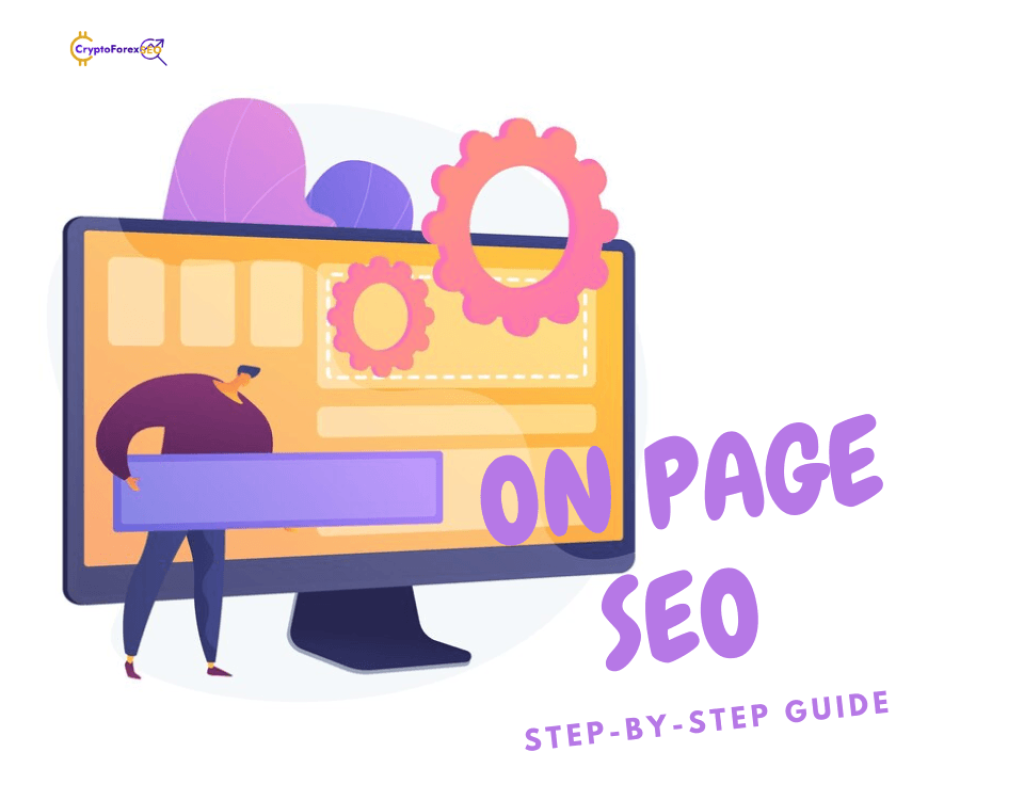
The crypto and forex industries are some of the most competitive online spaces. Every day, trading platforms, brokers, exchanges, and affiliate blogs fight for visibility on Google. If your website isn’t optimized properly, you won’t rank, which means fewer visitors, fewer sign-ups, and fewer conversions.
You might already have great content, detailed forex trading strategies, crypto investment guides, or in-depth broker comparisons. But if your on-page SEO is weak, Google won’t prioritize your site over competitors who have better structured, keyword-optimized, and user-friendly pages.
💡 The good news? If you master on-page SEO, you can improve rankings, drive targeted traffic, and increase conversions—even in this highly competitive space.
In this guide, you’ll learn:
✅ How to optimize title tags, meta descriptions, and URLs for SEO
✅ How to structure content for better rankings & user engagement
✅ The role of Core Web Vitals, mobile SEO, and page speed
✅ How to implement schema markup for better visibility in search results
✅ Common on-page SEO mistakes to avoid
Let’s get started.
Table of Contents
ToggleOn-page SEO starts with keywords. You could have the best content in the industry, but if you’re not targeting the right keywords—or mapping them correctly—you’re leaving traffic, leads, and revenue on the table.
In the crypto and forex niches, keyword strategy is more than just stuffing in high-volume search terms. You need to understand intent, identify ranking opportunities, and strategically map keywords to the right pages.
Tools Needed:
✅ Ahrefs – For keyword difficulty, search volume, and competitor analysis
✅ SEMrush – For keyword gap analysis and ranking insights
✅ Google Keyword Planner – For search volume & long-tail keyword discovery
Crypto and forex aren’t like other industries—they have rapid market changes, regulatory updates, and high search volatility.
Example:
💡 The goal isn’t just to target the biggest keywords but to find the most strategic ones.
1️⃣ Start with Seed Keywords
2️⃣ Expand with Long-Tail & Question-Based Keywords
3️⃣ Check Search Volume & Difficulty (Ahrefs, SEMrush)
4️⃣ Analyze Competitor Keywords (Ahrefs Keyword Gap Tool)
Pro Tip: Don’t just focus on high-volume keywords. Targeting specific, intent-driven keywords will bring in the right audience—not just random traffic.
Google ranks pages based on intent, not just keywords. That’s why some forex brokers can’t rank for “best forex brokers” but dominate for “how to trade forex as a beginner.”
Search Intent | Example Keyword | Content Type to Rank |
Informational | “How does forex trading work?” | Blog post, beginner’s guide |
Commercial | “Best forex brokers for low spreads” | Comparison article, reviews |
Transactional | “Sign up for Binance” | Landing page, sign-up page |
Navigational | “MetaTrader 4 login” | Homepage, product page |
Pro Tip: If you’re optimizing for transactional keywords, don’t create a blog post—Google expects landing pages.
One of the biggest mistakes in SEO is not mapping keywords to the right pages.
Imagine you’re targeting “best crypto wallets” and writing a blog post instead of optimizing a dedicated comparison page—you’re wasting ranking potential.
Keyword Type | Where to Use It? |
Broad Category Keywords | Homepage, category pages |
Informational Keywords | Blog posts, FAQs |
Comparison & Review Keywords | Comparison pages, detailed reviews |
Transactional Keywords | Product pages, sign-up pages |
Pro Tip: Use Google Search Console to check which keywords are already ranking for specific pages, then optimize them further.
Many forex and crypto sites make the mistake of only targeting short-tail keywords (e.g., “forex trading”). These keywords are extremely competitive and rarely convert well.
Example:
❌ “Forex trading” → 1M+ searches but dominated by massive websites.
✅ “Forex trading for beginners with $100” → 5K searches, much easier to rank, and high intent.
Pro Tip: Long-tail keywords drive more conversions than short-tail ones because users are searching for specific solutions.
Your keyword strategy is now in place, time to implement it!
Your title tag and meta description are the first things people see in Google search results. Even if your page ranks on the first page, a weak title and description will get ignored, while a well-optimized one can skyrocket your click-through rate (CTR)—bringing in more traffic without changing rankings.
Think about it like this: Your title and meta description are your ad copy. Would you click on a boring, generic title, or one that promises exactly what you need?
💡 SEO isn’t just about rankings; it’s about earning the click.
Tools Needed:
✅ Screaming Frog – Find missing or duplicate title tags & meta descriptions
✅ Yoast SEO (for WordPress users) – Optimize title tags & meta descriptions easily
✅ Surfer SEO – Analyze competitor SERPs & optimize for keyword placement
Your title tag is the most important on-page SEO element because:
Bad Example (Weak Title):
“Forex Trading Strategies | Learn How to Trade Forex”
🔴 Why it’s bad: Generic, doesn’t stand out, lacks emotional pull.
Good Example (Optimized Title):
“5 Proven Forex Trading Strategies That Work (Backtested Results)”
✅ Why it’s good:
– Uses a number (“5”) to make it more clickable.
– Includes “Proven” for credibility.
– Uses “Backtested Results” to show real value.
Another Example for Crypto:
❌ “Best Crypto Wallets for Beginners” (too generic)
✅ “Best Crypto Wallets for Beginners (Security & Fees Compared)”
Title Tag Length: Keep it 50-60 characters max—Google cuts off anything longer.
Meta Description Length: Keep it 130-160 characters for full visibility in search results.
1️⃣ Run Screaming Frog SEO Spider → Look at “Page Titles” section.
2️⃣ If titles exceed 60 characters, rewrite them to fit within limits.
Meta descriptions don’t directly impact rankings, but they DO affect CTR. And a higher CTR sends positive signals to Google, helping you rank better over time.
Bad Example (Weak Meta Description):
“Learn about the best forex trading strategies and how to trade forex effectively. Get started today!”
🔴 Why it’s bad: Boring, lacks urgency, doesn’t stand out.
Good Example (Optimized Meta Description):
“Want to boost your forex trading profits? Discover 5 backtested forex strategies that work—plus real-world examples. Read now!”
✅ Why it works:
✔️ Speaks directly to the user’s pain point (“boost profits”).
✔️ Uses a CTA (“Read now!”) to encourage action.
📌 Another Good Example for Crypto:
“Confused about which crypto wallet to use? We compared the top 5 wallets based on security, fees, and ease of use. Find out which one is best for you!”
With optimized title tags & meta descriptions, you’ll see higher CTRs & more organic traffic.

URL structure and site navigation are the backbone of on-page SEO. A well-organized website isn’t just easier for users to navigate but also easier for Google to crawl and index, leading to higher rankings.
💡 Why URL Structure & Navigation Matter for Crypto & Forex SEO:
Let’s break down how to optimize URLs and site structure for crypto & forex websites.
Tools Needed:
✅ Google Search Console – To check indexed URLs & crawl errors
✅ Screaming Frog – To analyze site structure & detect broken links
URLs should be clean, descriptive, and optimized for search engines. A bad URL structure can confuse Google and lead to lower rankings.
Bad Example (Messy URL):
❌ cryptoforesseo.com/p=12345?sessionid=xyz (Confusing, meaningless)
Good Example (SEO-Friendly URL):
✅ cryptoforesseo.com/forex-trading-strategies (Clear & keyword-rich)
Other Example for a Crypto Broker Page:
❌ cryptoforesseo.com/category/brokerpage123
✅ cryptoforesseo.com/best-crypto-brokers
Breadcrumbs are navigational links that show users where they are on your site.
💡 Example of Breadcrumb Navigation:
Homepage > Forex Strategies > Swing Trading Strategy
✔️ Use Yoast SEO plugin → Go to “Search Appearance” → Enable breadcrumbs.
✔️ If using custom code, implement structured data for breadcrumbs.
Internal links help distribute SEO authority across your website. A well-linked page ranks higher than an isolated page.
Example of Good Internal Linking:
In a blog post about crypto trading strategies, link to:
-cryptoforesseo.com/best-crypto-wallets (If discussing wallet security)
-cryptoforesseo.com/crypto-exchange-comparison (If mentioning exchanges)
A well-structured site helps both users and search engines find content easily.
📌 Best Practices for SEO-Friendly Navigation:
📌 Bad Navigation Example:
Homepage > Blog > Archives > 2023 > Trading Strategies > Forex Trading
🚨 Problem: Too many layers before reaching the forex trading content.
📌 Good Navigation Example:
Homepage > Forex Trading Strategies
Homepage > Best Crypto Exchanges
Fewer clicks = Faster access = Better ankings.
Organise your website into a silo structure for category pages to improve navigation and topic Relevance.
✅ A strong site structure = Better rankings & user experience.
Content is the lifeblood of SEO, but in the crypto and forex space, not just any content will rank. Google expects expert-level, authoritative, and user-focused content, especially since these industries fall under YMYL (Your Money, Your Life) guidelines.
Simply stuffing keywords into your articles won’t cut it. Instead, you need to structure, optimize, and write content that is NLP-friendly, engaging, and highly relevant to user intent.
Let’s break down how to create content that ranks and converts.
Tools Needed:
✅ Surfer SEO – Optimize keyword usage & content structure
✅ Clearscope – Find semantically related terms (LSI keywords)
✅ Google NLP API – Understand how Google interprets your content
Google’s Helpful Content Update prioritizes well-researched, high-value content over generic, AI-generated articles.
🚨 If your forex or crypto site has:
❌ Thin or repetitive content → Rankings will drop.
❌ Overly promotional content → Google won’t rank it.
❌ Unstructured content → Users won’t engage, leading to high bounce rates.
💡 The key to ranking: Write high-quality, structured, and intent-driven content.
✅ Primary keyword in the first 100 words.
✅ Engaging intro that immediately hooks the reader.
✅ Subheadings (H2s, H3s) with related LSI keywords.
✅ Short, scannable paragraphs (Google prefers easy-to-read content).
✅ Internal links to relevant pages (boosts SEO and user retention).
✅ Stats, case studies, and external links to authoritative sources.

“Latent Semantic Indexing” (LSI) keywords are phrases or words that are conceptually related to a target keyword, which means they are semantically connected based on context. “Natural Language Processing” (NLP) is the technology used to find these relationships between words, which lets computers understand what text means like humans do.
LSI keywords are found by using NLP techniques to look at how words relate to each other within a certain topic.
Google no longer relies solely on exact-match keywords. Instead, it uses Latent Semantic Indexing (LSI) and Natural Language Processing (NLP) to understand context and meaning.
💡 Example:
Instead of just using “best forex broker”, Google expects you to include related terms like:
✔️ Low spread brokers
✔️ Trading fees comparison
✔️ Regulated forex brokers
✔️ Leverage & margin trading
1. Use Google Auto-Suggest & People Also Ask → Identify common search variations.
2. Check Surfer SEO or Clearscope → Find LSI keyword recommendations.
3. Add semantic terms naturally—don’t over-optimize or keyword stuff.
📌 Example of LSI Keyword Placement (Crypto Blog Post):
❌ Bad: “This is the best crypto wallet. A crypto wallet stores crypto securely.”
✅ Good: “Choosing the best crypto wallet depends on security, ease of use, and whether you prefer a cold wallet like Ledger or a hot wallet like MetaMask.”
Takeaway: Write naturally but ensure Google recognizes relevant keywords.
Heading tags are crucial for SEO and user experience. Google scans headings to understand content structure, while users rely on them for easy navigation.
✔️ Use only ONE H1 per page (This is your main title).
✔️ Break content into logical sections using H2s & H3s.
✔️ Use keywords in headings naturally (Don’t force them).
✔️ Avoid generic subheadings like “Introduction”—be descriptive instead.
Example of Good Heading Structure (Forex Trading Guide):
H1: The Ultimate Guide to Forex Trading Strategies
H2: What is Forex Trading?
H2: Best Forex Trading Strategies for Beginners
H3: Scalping Strategy
H3: Swing Trading Strategy
H2: How to Manage Risk in Forex Trading
Takeaway: Properly structured headings improve rankings and readability.
Most readers decide within 10 seconds if they’ll stay on your page.
A Good Introduction Should:
📌 Bad Example:
“Forex trading is popular worldwide. Many people trade forex to make money. In this guide, we will talk about forex trading.”
🚨 Problem: Boring, vague, and keyword-stuffed.
Good Example (Optimized for Engagement & SEO):
“The crypto and forex industries are some of the most competitive online spaces. Every day, trading platforms, brokers, exchanges, and affiliate blogs fight for visibility on Google. If your website isn’t optimized properly, you won’t rank, which means fewer visitors, fewer sign-ups, and fewer conversions.”
✅ Why it works: Speaks directly to the reader, creates curiosity, and sets clear expectations.- It is exactly the introduction of this page, see how far you got reading this piece
Takeaway: Hook your reader FAST, or they’ll bounce.
Schema markup is structured data added to your website to help search engines better understand your content. Google loves structured data for that very reason.
Imagine you’re searching for “best forex brokers for beginners” on Google. You see two results:
Which one would you click? Probably the second one.
That’s the power of schema markup—it helps your site stand out in search results, improving click-through rates (CTR), rankings, and credibility.
💡 The challenge? Many forex and crypto sites don’t use schema markup properly, missing out on higher rankings and better engagement.
Adding schema markup can help you rank in:
Tools Needed:
✅ Schema Markup Validator (validator.schema.org) – Test structured data implementation.
✅ Google Search Console – Monitor rich snippet performance.
✅ Rank Math / Yoast SEO (for WordPress users) – Easy schema integration.
Schema Type | Best Use Case |
FAQ Schema | Crypto & forex educational guides |
Article Schema | Blog posts & in-depth guides |
Product Schema | Broker & exchange reviews |
How-To Schema | Step-by-step tutorials |
Takeaway: Adding structured data increases your chances of ranking in featured snippets.
With optimized content, your pages will rank higher, engage users better, and drive more traffic.
Google loves video content and well-optimized images—and so do users. Visual content boosts engagement, improves rankings, and enhances user experience. But it’s not just about adding videos and images; optimization is key.
In the crypto and forex space, images and videos are critical for engaging users and enhancing SEO, where traders rely on charts, graphs, and video tutorials to make informed decisions. However, many websites fail to optimize media properly, leading to slow page speeds, poor rankings, and lower conversions.
💡 Why Image & Video SEO Matters:
Let’s optimize your crypto and forex media files to boost rankings, engagement, and site performance.
Tools Needed:
✅ TinyPNG – Compress images without losing quality
✅ ImageOptim – Reduce image size for faster loading
✅ YouTube SEO tools – Optimize videos for search rankings
Alt text is a short, descriptive phrase added to an image’s HTML code that:
Bad Example (Generic & Unoptimized):
❌ alt=”chart”
❌ alt=”crypto trading”
Good Example (Optimized for SEO & User Experience):
✅ alt=”BTC/USD price chart showing a breakout above resistance level”
✅ alt=”Forex candlestick pattern for EUR/USD reversal strategy”
Pro Tip: Traders often search for charts and trading strategies in Google Images, so optimized alt text helps drive more traffic.
🚨 Unoptimized images = Slow page speed = Higher bounce rates = Lower rankings.
💡 A 3-second delay in page speed can result in a 32% increase in bounce rate. (Source: Google)
✔️ Use proper file formats:
📌 Example of Compressed Image Impact:
Pro Tip: Use Cloudflare or BunnyCDN to serve images faster worldwide.
✔️ Use target keywords in the video title & description.
✔️ Add timestamps (chapters) for better UX & SEO.
✔️ Optimize video file size before embedding (large videos slow down sites).
✔️ Host videos on YouTube/Vimeo instead of directly uploading them (to reduce page load time).
✔️ Use an SEO-friendly video thumbnail (high contrast, clear text, engaging design).
📌 Example of an SEO-Optimized YouTube Title & Description:
✅ Title: Best Forex Trading Strategies (Scalping, Swing, & Day Trading Explained)
✅ Description:
“Looking for the best forex trading strategy? In this video, we cover scalping, swing trading, and day trading strategies, with real chart examples. Learn how to optimize risk management and maximize profits!”
Pro Tip: Videos with keyword-rich descriptions & timestamps rank higher.
🔹 Optimize all images (compress, resize, and use proper formats).
🔹 Write SEO-friendly alt text (descriptive, keyword-rich, but natural).
🔹 Host videos on YouTube (don’t upload directly to your server).
🔹 Add video schema markup to help Google recognize video content.
With optimized images & videos, your site will load faster, rank better, and engage users more effectively.
“Google ranks pages that satisfy search intent, keep users engaged, and provide real value—not just those stuffed with keywords.” Matthew Woodward- Founder Search Logistics
Focus on delivering the best experience, and Google will reward your site accordingly. 🚀
Google doesn’t just rank individual pages, it ranks entire sites based on their authority on a subject. This is why some forex and crypto sites dominate rankings across multiple keywords, while others struggle to even appear on page one.
💡 The secret? A strong internal linking strategy and well-structured content clusters.
If your site is just a collection of random blog posts with no connection, Google won’t recognize it as an authority. But if your content is strategically linked and structured, you’ll boost rankings, improve user engagement, and establish your site as a trusted resource.
Tools Needed:
✅ Screaming Frog – Identify internal linking opportunities
✅ Ahrefs Site Explorer – Find underperforming pages & keyword gaps
✅ Internal Link Auditors (LinkWhisper, Surfer SEO) – Automate internal linking suggestions
A content silo is an SEO strategy that organizes related content into structured categories. Instead of random, unconnected pages, your site should have topic-based clusters that support pillar pages (main guides).
Why Content Silos Work:
✔️ Google sees structured sites as authoritative → Improves overall rankings.
✔️ Users can easily navigate between related topics → Increases engagement.
✔️ Each page supports others → Strengthens overall SEO performance.
Takeaway: A well-organized content structure builds authority and boosts rankings.
✔️ Use keyword-rich anchor text (but don’t over-optimize).
✔️ Link to high-priority pages from relevant blog posts.
✔️ Avoid orphan pages (pages with zero internal links).
✔️ Ensure a logical link flow—don’t force links that don’t make sense.
Example of a Good Internal Link:
✅ “Looking for a forex trading strategy? Check out our best scalping strategies to maximize quick profits.”
Takeaway: Strategic internal linking boosts weaker pages and improves rankings.
A pillar page is a comprehensive guide on a broad topic that links to smaller, related pages (cluster pages).
Example of a Pillar Page in Crypto SEO:
Pillar Page: “Ultimate Guide to Crypto Trading”
🔹 Cluster Page 1: “How to Read Crypto Candlestick Patterns”
🔹 Cluster Page 2: “Best Crypto Trading Platforms Compared”
🔹 Cluster Page 3: “Crypto Trading Strategies for Beginners”
Why Pillar Pages Work:
Takeaway: Pillar pages + topic clusters = long-term SEO success.
❌ Too many links on one page—Dilutes link equity and confuses Google.
❌ Over-optimizing anchor text—Using the same keyword in every link looks unnatural.
❌ Keyword cannibalization—Multiple pages competing for the same keyword.
✔️ Use canonical tags to signal the primary page.
✔️ Merge similar pages if they compete for the same keyword.
✔️ De-optimize secondary pages and link them to the primary page instead.
Takeaway: Be strategic—don’t overdo internal linking or create competing pages.
With a strong internal linking strategy, your site will be more authoritative, rank higher, and drive more traffic.
A slow website kills conversions, rankings, and trust; especially in the crypto and forex industry, where traders rely on real-time data and instant access to information.
I once worked with a forex broker who couldn’t figure out why their bounce rate was over 75%, even though they had high-quality content and thousands of visitors per month. After running a Core Web Vitals audit, we found the issue:
❌ Their website took 4.8 seconds to load—and most visitors left before even seeing the content.
❌ Their mobile UX was terrible—buttons were too small, and the page layout broke on different devices.
❌ Their images were massive files—taking up unnecessary bandwidth.
After fixing these issues, their bounce rate dropped to 38%, and their organic traffic increased by 65% in just two months.
💡 Here’s how you can do the same—optimize your website’s speed, mobile experience, and user engagement for better rankings and conversions.
Tools Needed:
✅ Google PageSpeed Insights – Analyze Core Web Vitals
✅ GTmetrix – Identify speed bottlenecks
✅ Lighthouse (Chrome DevTools) – Test UX and site performance
Google has officially confirmed that page speed is a ranking factor, not just for desktop but for mobile searches too.
Google measures user experience (UX) performance using three main metrics:
Metric | What It Measures | Ideal Score |
Largest Contentful Paint (LCP) | How fast the largest element (image, text, video) loads | <2.5 seconds |
First Input Delay (FID) | Time before a page is interactive (e.g., clicking a button) | <100ms |
Cumulative Layout Shift (CLS) | Stability of the page layout (avoiding sudden shifts) | <0.1 |
📌 Example of Bad UX from a Crypto Trading Platform:
Takeaway: Slow, unstable pages = Lost traffic & lost revenue.
❌ Problem: High-resolution charts, forex graphs, and background images slow down the page.
✅ Fix: Use TinyPNG, ShortPixel, or ImageOptim to compress images by 50-80% without visible quality loss.
Example Impact of Image Compression:
Lazy loading prevents images and videos from loading until they’re actually needed, reducing initial load time.
📌 How to Enable Lazy Loading (WordPress Users):
📌 How to Enable Lazy Loading (Custom Websites):
Use this HTML attribute:
<img src=”forex-chart.jpg” loading=”lazy” alt=”Forex trading chart”>
Takeaway: Lazy loading can reduce page size by 30-50% and improve LCP scores instantly.
A CDN stores cached versions of your site across multiple servers worldwide, ensuring faster access for users in different locations.
📌 Best CDN Options for Crypto & Forex Websites:
✅ Cloudflare (Free & Paid) – Great for global coverage.
✅ BunnyCDN – Low-cost and super-fast.
✅ Amazon CloudFront – Scalable & reliable.
Takeaway: If your audience is global (like most crypto & forex sites), a CDN is a must-have.
Over 60% of forex & crypto searches happen on mobile devices. Google prioritizes mobile-first indexing. If your site isn’t optimized for mobile, expect lower rankings.
📌 Test Mobile-Friendliness:
Use Google’s Mobile-Friendly Test (search.google.com/test/mobile-friendly).
Takeaway: Mobile-friendliness directly impacts rankings and user experience.
SEO isn’t just about ranking—it’s about keeping users on your site. If visitors leave within seconds, Google assumes your content isn’t valuable and ranks you lower.
✔️ Use a clear, easy-to-read font (no tiny text).
✔️ Break up text with bullet points & visuals (avoid long walls of text).
✔️ Ensure CTAs (Call-to-Actions) are visible (e.g., “Sign Up Now” buttons).
✔️ Reduce intrusive ads—Google penalizes sites with aggressive pop-ups.
📌 Example of a UX Mistake in a Crypto Blog:
❌ A visitor clicks a blog titled “Best Crypto Exchanges Compared”
❌ The page has 10+ ads, autoplay videos, and a giant pop-up asking them to subscribe.
❌ They leave immediately, increasing the bounce rate.
🚀 Takeaway: A good UX means fewer bounces, higher engagement, and better SEO rankings.
With a fast, mobile-friendly, and user-optimized site, you’ll rank higher, reduce bounce rates, and increase conversions.

Even the most well-intentioned crypto and forex websites make on-page SEO mistakes that silently kill rankings.
A while back, I worked with a forex signals provider who couldn’t understand why their traffic was flat despite publishing content weekly. After an audit, we found:
❌ Keyword stuffing—They forced “best forex signals” into every paragraph.
❌ No internal linking—New blog posts were isolated with no links to older, high-authority pages.
❌ Long, ugly URLs—Some pages had “?p=5678” instead of descriptive slugs.
After fixing these errors, they saw a 40% traffic boost in 8 weeks—without changing their content strategy.
If your rankings are stuck, chances are you’re making some of these mistakes too.
Google is smart enough to recognize synonyms and context. If your content looks unnatural, expect lower rankings.
Bad Example (Keyword Stuffing in a Forex Blog):
“Forex traders looking for the best forex trading strategy should consider a forex trading strategy that suits their forex trading style.”
Better Example (Natural Keyword Usage):
✅ “Choosing the right forex trading strategy depends on your risk tolerance and market experience. Scalping is great for fast trades, while swing trading suits long-term traders.”
Fix: Use LSI keywords and NLP-friendly writing to avoid robotic content.
A common mistake? Writing great blog posts but not linking them to related pages.
Bad Example:
A post on “How to Trade Crypto with Leverage” has no internal links to an existing guide on “Crypto Risk Management.”
Better Approach:
✅ The post includes: “Leverage can amplify gains but also increase risk. Learn more in our crypto risk management guide.” (internal link)
Fix: Every blog post should link to at least 3-5 related articles to improve SEO and user engagement.
Google and users prefer clear, keyword-rich URLs.
Bad URL:
❌ cryptoforesseo.com/post?id=4567
SEO-Friendly URL:
✅ cryptoforesseo.com/best-crypto-exchanges-2024
Fix: Keep URLs short, relevant, and free of unnecessary parameters.
Google ranks your site based on its mobile version. If your mobile experience is poor, expect lower rankings.
Signs Your Mobile SEO is Failing:
❌ Text is too small (users must zoom to read).
❌ Buttons are too close together (bad UX).
❌ Pages load slowly (no image compression or lazy loading).
Fix: Use Google’s Mobile-Friendly Test to identify and fix mobile issues.
Meta descriptions don’t directly affect rankings but impact CTR—which indirectly influences SEO.
Bad Example (Generic Meta Description):
❌ “Learn about forex trading strategies and how to get started.”
Better Example (Engaging & SEO-Optimized):
✅ “Struggling with forex trading? Discover 5 proven strategies top traders use to maximize profits. Read now!”
Fix: Ensure every page has a unique, compelling meta description with a clear CTA.
SEO in the crypto and forex space isn’t just about publishing content, BUT ALSO about optimizing every page for search engines and users.
By now, you understand that on-page SEO is more than just keywords. It’s about delivering a fast, structured, and engaging user experience while following Google’s best practices.
💡 Let’s recap your next steps:
If you follow these steps, you’ll:
If you need a professional SEO audit, content strategy, or technical fixes, we can help.
📩 Get a Free On-Page SEO Audit and let’s get your crypto or forex website the attention it deserves!

Ray Max
SEO Content Writer
Jeffers Abaga is the founder and CEO of Crypto Forex SEO, an agency dedicated to helping crypto, forex, and blockchain businesses dominate search rankings. With over 5 years of experience in digital marketing, SEO, and business management, he has successfully scaled multiple brands through strategic SEO, content marketing, and conversion optimization.His expertise spans technical SEO, link building, on-page optimization, and brand positioning, making him a trusted voice in the industry. Passionate about data-driven growth, he ensures Crypto Forex SEO delivers high-impact SEO solutions tailored specifically for the crypto and forex space.
Fill the form below to schedule your FREE SEO consultation today!


Your audience is searching for solutions. Let’s make sure they find YOU. Crypto and forex markets don’t wait, and neither do your competitors.
641 Lexington Avenue 14th Floor, New York- USA
+1(212)3658463
The Address 7th Floor
Muthangari Dr, Nairobi- KE
+254 728 115688
© 2025 CryptoForexSEO
All right reserved.